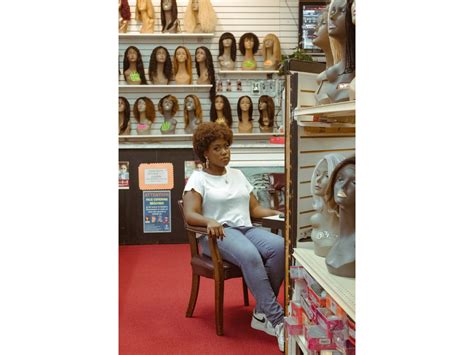Introduction:
Black women’s hair has a rich and vibrant history that is inextricably linked to their culture, identity, and experiences. Through centuries of oppression, discrimination, and social upheaval, black women have used their hair as a form of self-expression, resistance, and empowerment.

Historical Roots:
500 Years of Enslavement:
During the transatlantic slave trade, African women’s hair was forcibly shaved off as a means of control and dehumanization. This practice served to strip them of their cultural identity and erase their connection to their ancestral traditions.
Emancipation and the Victorian Era:
After the abolition of slavery, black women faced ongoing societal pressures to conform to Eurocentric beauty standards, which prioritized straight, long hair. This led many women to adopt hairstyles such as wigs, hair extensions, and chemical treatments that damaged their natural hair.
The Natural Hair Movement:
The 1960s and Black Power:
The Civil Rights Movement of the 1960s sparked a wave of black consciousness and a return to natural hair styles. This movement, championed by icons such as Angela Davis and Shirley Chisholm, embraced the beauty of Afro-textured hair and challenged dominant beauty norms.
The 1990s and the Rise of Natural Beauty:
In the 1990s, the natural hair movement gained further momentum with the rise of black feminist writers, activists, and media figures who promoted self-acceptance and the celebration of natural beauty. This led to a proliferation of natural hair products and services tailored to the specific needs of black women.
Styles and Techniques:
Braids, Twists, and Locs:
Black women have developed a wide range of braiding, twisting, and locing techniques that are both functional and aesthetically pleasing. These hairstyles provide protection from the elements, prevent breakage, and enhance the natural beauty of Afro-textured hair.
Weaves, Extensions, and Wigs:
While natural hair is celebrated, black women also embrace a variety of hair extensions, weaves, and wigs. These methods provide versatility, allow for different styles, and address hair challenges such as thinning or damage.
Cultural Impact:
Symbolism and Identity:
Black women’s hair has profound cultural significance. It is a source of pride and a representation of their heritage, resilience, and strength. Hairstyles can convey social status, marital status, and even political beliefs.
Economic Empowerment:
The natural hair care industry is a multi-billion dollar global market, with black women representing a significant portion of its customer base. Black women-owned hair salons, product lines, and businesses have emerged as a source of economic empowerment and entrepreneurship.
Social Challenges:
Hair Discrimination:
Despite progress towards greater acceptance, black women still face discrimination based on their hair. Laws such as the CROWN Act, which prohibits discrimination against natural hairstyles, are being introduced to address this issue.
Health Concerns:
Certain hair treatments and products can damage black women’s natural hair, leading to breakage, thinning, and scalp issues. It is important for women to be informed about the potential risks and to use products that are formulated for their hair type.
The Future of Black Women’s Hair:
Inclusion and Representation:
The movement towards inclusivity in fashion, beauty, and media is creating a more welcoming environment for black women to embrace their natural hair. Representation is essential for empowering women and challenging societal biases.
Innovation and Technology:
Advances in technology are leading to the development of new hair care products and services specifically designed for black women. These innovations aim to address common hair challenges and provide healthier and more effective hair solutions.
Conclusion:
Black women’s hair is a testament to their resilience, beauty, and cultural diversity. Through centuries of adversity, they have used their hair as a means of self-expression, resistance, and empowerment. Today, the natural hair movement continues to flourish, empowering black women to embrace their unique beauty and challenge societal norms. As we move forward, it is imperative to promote inclusivity, raise awareness about hair discrimination, and invest in research and innovation that supports the health and well-being of black women’s hair.
- According to the U.S. Census Bureau, black women make up about 13.4% of the U.S. population.
- The natural hair care market is estimated to be worth over $8 billion globally, with black women accounting for approximately 80% of consumers.
- A 2019 study by Dove found that 63% of black women have experienced hair discrimination at some point in their lives.
- A 2022 study by the Journal of the National Medical Association found that 56% of black women report having scalp damage from hair styling practices.
Table 1: Common Black Women’s Hair Textures
| Texture | Description |
|---|---|
| Type 4A | Coily, tightly curled |
| Type 4B | Zigzag, tightly coiled, wiry |
| Type 4C | Very tightly coiled, fragile |
Table 2: Protective Hairstyles for Black Women
| Hairstyle | Benefits |
|---|---|
| Braids | Protect ends, prevent breakage |
| Twists | Similar to braids, but with a looser curl |
| Locs | Permanent hairstyle, can last for years |
| Wigs | Versatile, allows for different styles |
Table 3: Hair Care Tips for Black Women
| Tip | Benefits |
|---|---|
| Avoid excessive heat styling | Prevents damage |
| Use products specifically formulated for black hair | Nourishes and protects |
| Deep condition regularly | Maintains moisture and elasticity |
| Protect hair from the elements | Uses scarves, hats, or sunscreens |
Table 4: Resources for Black Women’s Hair
| Organization | Website |
|---|---|
| The CROWN Act | https://www.thecrownact.com |
| Black Women’s Health Imperative | https://www.bwhi.org |
| Natural Hair Care & Styling Guide | https://www.naturallycurly.com |
